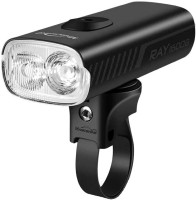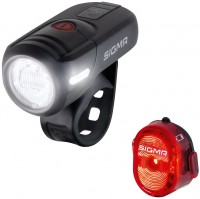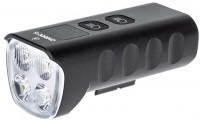Як вибрати потужний велосипедний ліхтар
Ми незалежно перевіряємо товари та технології, які рекомендуємо.

1. Переднє (головне) світло
Передня велофара служить в якості основного джерела світла. Вона застосовується як для освітлення дороги, так і для покращення помітності велосипедиста для зустрічного транспорту чи пішоходів. Під час поїздок у темний час доби передня фара є обов'язковим атрибутом оснащення велосипеда відповідно до ПДР.
Майже всі сучасні велофари головного світла працюють на світлодіодах. Як правило, вони випромінюють біле світло і можуть мати кілька режимів яскравості для освітлення дороги на різну дистанцію.
2. Заднє освітлення
Під заднім освітленням зазвичай розуміються маячки червоного кольору. Їх завдання полягає у підвищенні видимості велотранспорту ззаду для інших учасників дорожнього руху. Задній ліхтар може працювати у режимі безперервного світіння або ж бликового маячіння. Власне, останній варіант дав характерну назву задньому освітлювальному обладнанню, яке прийнято іменувати мигалками.
3. Яскравість світового потоку та кольорова температура
Основною характеристикою для велофар головного світла є світловий потік у люменах (лм). Цей параметр відображає, наскільки яскраво можуть світити LED-діоди у конструкції ліхтаря (без урахування розсіювання світла). За яскравістю світлового потоку велосипедні фари умовно поділяються на чотири підгрупи:
- малопотужні (приблизно до 100 – 200 лм) — забезпечують видимість на ближніх дистанціях, тобто безпосередньо перед колесами;
- середні (приблизно до 500 лм) — підходять для нічної їзди на невисоких швидкостях;
- потужні (від 500 до 1000 лм) — підходящий варіант для швидкісної їзди і легкого орієнтування на незнайомій місцевості в темний час доби;
- надпотужні (понад 1000 лм) — фари-прожектори, що забезпечують прекрасну видимість дорожньої обстановки у суцільній темряві.
Дійсно потужне світло знадобиться на заміських дорогах і пересіченій місцевості, тоді як для міських поїздок з вуличним освітленням цілком вистачить світла від малопотужної фари.

Поряд зі світловим потоком важливу роль відіграє кольорова температура джерела освітлення. Оптимальний всепогодний варіант — це нейтрально біле світло (в межах порядку 5000 – 6000 К). Надто теплі кольорові відтінки можуть виявитися на практиці тьмяними, а занадто «холодні» є недостатньо контрастними.
4. Кут розсіювання світла та дальність освітлення
Наскільки широко буде освітлюватися дорога попереду, залежить від кута розсіювання світла. Вибір за цим показником безпосередньо залежить від індивідуальних потреб райдера. Чим ширший кут розсіювання (наприклад, у межах 150 – 170°), тим більше простору освітлює велофара близько переднього колеса. Однак широка область освітлення апріорі не може бути дальнобійною. І навпаки — вузький пучок світла (на рівні 15 – 20°) призначається для точкового підсвічування обмеженої області на далеких відстанях, аби краще бачити дорогу вдалину.

тоді як вузькоспрямоване світло ефективно добиває на дальні відстані.
Ефективна дальність освітлення нерідко вказується конкретними цифрами у метрах. Проте критерії визначення ефективної дальнобійності променя від фари є доволі розмитими — вони сильно варіюються в залежності від виробника світлового обладнання та методик тестування. Проте параметр дозволяє наочно порівнювати між собою можливості тієї чи іншої велофари.
Окремо зазначимо, що для міських велопоїздок варто надавати перевагу фарам з козирком над лінзою та вираженою світлотіньовою межею. Ці елементи запобігають засліпленню учасників дорожнього руху зустрічного потоку.
5. Розумне освітлення
Головні велофари з розумним освітленням гнучко підлаштовують характер світла під швидкість руху. Зазвичай тут діє правило «чим швидше їде райдер, тим далі світить фара». Дані про швидкість беруться з бортового велокомп'ютера або навіть зв'язаного смартфона — в залежності від функціональних особливостей конкретної моделі.

для фіксації дорожньої обстановки за велорайдером.
Розумні задні мигалки можуть синхронізуватися з гальмами велосипеда. При уповільненні або зупинці байка вони вмикаються на максимальну яскравість, відіграючи роль стоп-сигналу.
6. Живлення і час автономної роботи
У переважній більшості велофари мають акумуляторне живлення від перезарядної батареї. Зручність її підзарядки часто забезпечується через USB-порт, що звільняє від необхідності використовувати фірмові зарядні пристрої. Бажано надавати перевагу моделям з часом автономної роботи від 2 годин у режимі максимальної яскравості, адже велопоїздки можуть тривати досить довго. На менш потужних режимах світіння такі фари зможуть забезпечити 3 – 6 годин автономності. Менш енергозатратні мигалки можуть працювати від вбудованого акумулятора довгими годинами поспіль. Загалом же час роботи вказується для ідеальних умов, які недосяжні в реальності. Тому повторимося — орієнтуйтесь на час автономності фари у режимі максимальної яскравості.
Автономне живлення від батарейок «AA» і «AAA» формату зустрічається у фарах головного світла на порядок рідше. Від таких же елементів живляться деякі моделі задніх мигалок. А в найбільш компактних габаритних ліхтарях може бути встановлено батарейка «таблеткового» формату CR2032.
Нікуди не поділися і відомі динамо-машини. Тільки тепер вони часто вбудовуються безпосередньо в втулку переднього колеса, постачаючи енергією велосипедні фари.

прийшли динамо-втулки для переднього колеса.
У просунутих реалізаціях динамо-машина доповнюється акумулятором або конденсатором для накопичення виробленої енергії — фари продовжать світити навіть під час зупинки байка. Динамо-втулки зустрічаються переважно в міських моделях велосипедів.
7. Герметичність та ударостійкість
Погодні капризи і дорожній пил висувають вимоги до надійної герметичності корпусу велофонарів. Щоби джерело світла не вийшло з ладу при першому ж виїзді в дощову погоду, варто придивитися до водонепроникних моделей. Ступінь захисту від пилу і вологи зазвичай вказується за стандартом IP — двома цифрами після абревіатури Ingress Protection. Перша цифра — це захист від пилу (максимум 6), друга — від води (максимум 8). Максимальний ранг захисту за цим стандартом записується у вигляді IP68. Проте, перша цифра може не вказуватися, оскільки ключовим параметром є саме захист від вологи. У такому разі ступінь водонепроникності буде виглядати як IPX7/IPX8.

Не зайвим буде і ударостійкість корпусу. Для екстремальних і активних дисциплін катання це взагалі «must have», а рядові райдери поцінують ударостійке виконання в плані кращої витривалості фари до вібрацій і струсу, які неминуче трапляються на дорожніх покриттях поганої якості та поза асфальтованими дорогами.
8. Кріплення на велосипед
Від типу кріплення безпосередньо залежить стабільність освітлення. Найбільш поширеним варіантом є гнучкі (еластичні) ремінці. Вони легко розтягуються, дозволяючи закріпити фару на кермі, рамі або підсідельному штирі, витративши на монтаж лічені секунди. Але при сильних вібраціях під час катання по нерівностях такі кріплення не забезпечують належної фіксації.
Стабільність положення фари в агресивних умовах їзди по пересіченій місцевості — прерогатива жорстких кріплень. Їх виготовляють з пластику і закріплюють на рамі за допомогою защіпки або характерного кронштейна. Так, це накладає обмеження на місце встановлення фари. Але вигода тут очевидна — джерела світла будуть закріплені абсолютно міцно.
Окремо заслуговують згадки велофари на еластичних резинках або липучках з кріпленням на шоломі райдера. Цей вид зазвичай є доповненням до жорсткого варіанту кріплення.
9. Світловідбивачі
Світлоповертаючі пристрої або катафоти (як їх називають у простонароді) використовуються як пасивні засоби безпеки. Вони підвищують помітність велосипедиста на дорозі в сутінках і темну пору доби. Катафоти відбивають світло, спрямоване в їхній бік.
Випускаються світловідбивачі у трьох основних кольорах:
- білий — спереду;
- оранжевий — збоку (як правило, між спицями коліс і/або в педалях);
- червоний — ззаду.
Наявність на велосипеді світловідбивачів і їхній колір регламентується правилами дорожнього руху або ж рекомендаціями автоінспекцій (в залежності від законодавчих норм у конкретних країнах).

Деякі катафоти можуть бути доповнені світлодіодами, які значно покращують помітність велосипеда на дорозі в умовах недостатньої видимості (особливо, в туманну погоду).
Статті, огляди, корисні поради
Усі матеріали



























































































